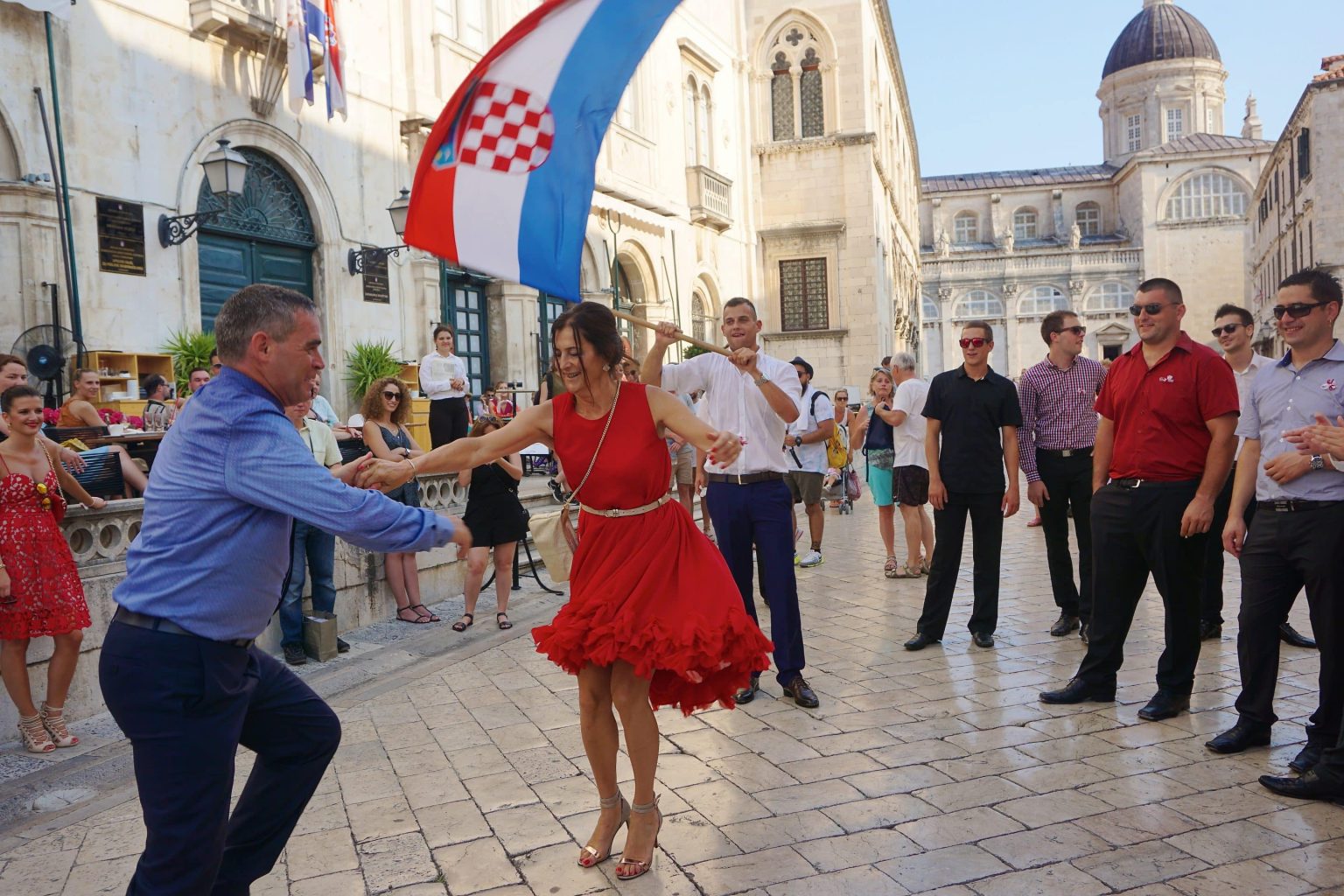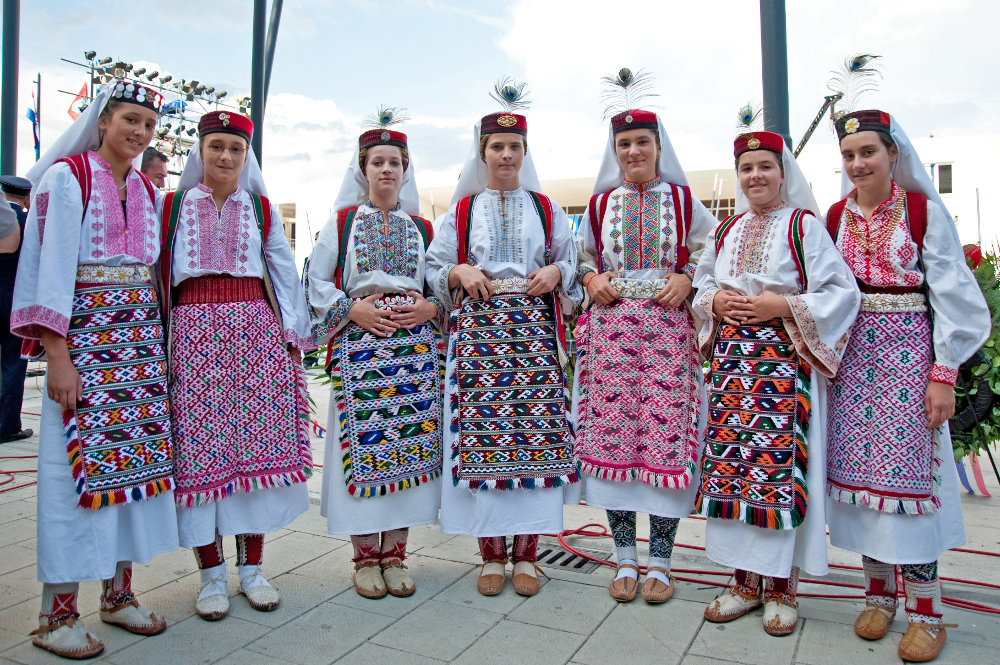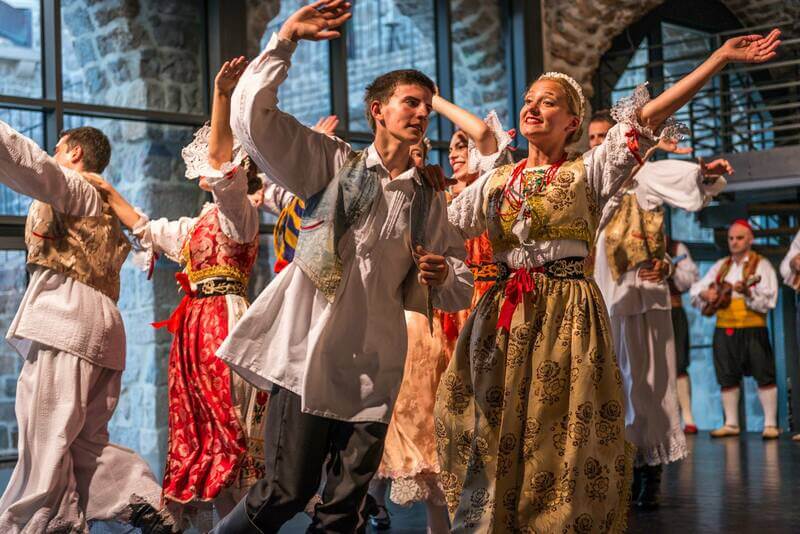Croatian weddings hold significant cultural importance as they are deeply rooted in the country’s history, traditions, and values. These weddings are not just private events but are considered important social occasions that bring families and communities together. Here are some cultural significances of Croatian weddings:
- Preservation of Heritage: Croatian weddings serve as a way to preserve and showcase the country’s rich cultural heritage. The incorporation of traditional costumes, music, dances, and rituals during the ceremonies reflects the pride the Croatians have in their cultural identity.
- Family and Community Bonding: Weddings in Croatia are seen as a time of great joy and celebration, uniting family members and friends. It’s an opportunity for people to come together, strengthen bonds, and share in the happiness of the newlyweds.
- Symbol of Continuity: Croatian weddings represent continuity and the passing down of traditions from one generation to the next. By adhering to customs that have been practiced for centuries, Croatians emphasize the importance of preserving their cultural values.
- Religious and Superstitious Beliefs: Croatia is a predominantly Catholic country, and weddings are often celebrated with a religious ceremony in a church. Many traditional customs and rituals have religious symbolism, which is significant for the couple and their families. Additionally, some customs, like the use of traditional bread or throwing rice, are believed to bring good luck and prosperity to the newlyweds.
- Expression of Hospitality: Croatian weddings are known for their hospitality and generosity. Hosting a lavish feast with abundant food and drinks for guests is a way to show appreciation and respect to attendees and to ensure they have a memorable time.
- Cultural Exchange: Weddings in Croatia can vary based on regional customs, and this diversity showcases the country’s cultural exchange and influences. Different regions may have unique traditions, costumes, and rituals, providing insight into the local way of life.
- Symbol of Love and Commitment: Like weddings around the world, Croatian weddings symbolize love, commitment, and the formation of a new family. They are an expression of the couple’s dedication to each other and their intention to build a life together.
- Economic and Social Significance: In some rural areas, weddings also have economic significance as they involve exchanging valuable gifts and contribute to the local economy through various businesses involved in wedding preparations.
- Community Support: Croatian weddings often involve the help and support of the extended family and friends in organizing and preparing for the event. This collective effort reinforces a sense of community support and cooperation.
Croatian weddings are a vibrant celebration of culture, love, and unity, reflecting the country’s deep-rooted traditions and values. They offer a glimpse into the rich history and heritage of Croatia while also serving as an important social and familial event.
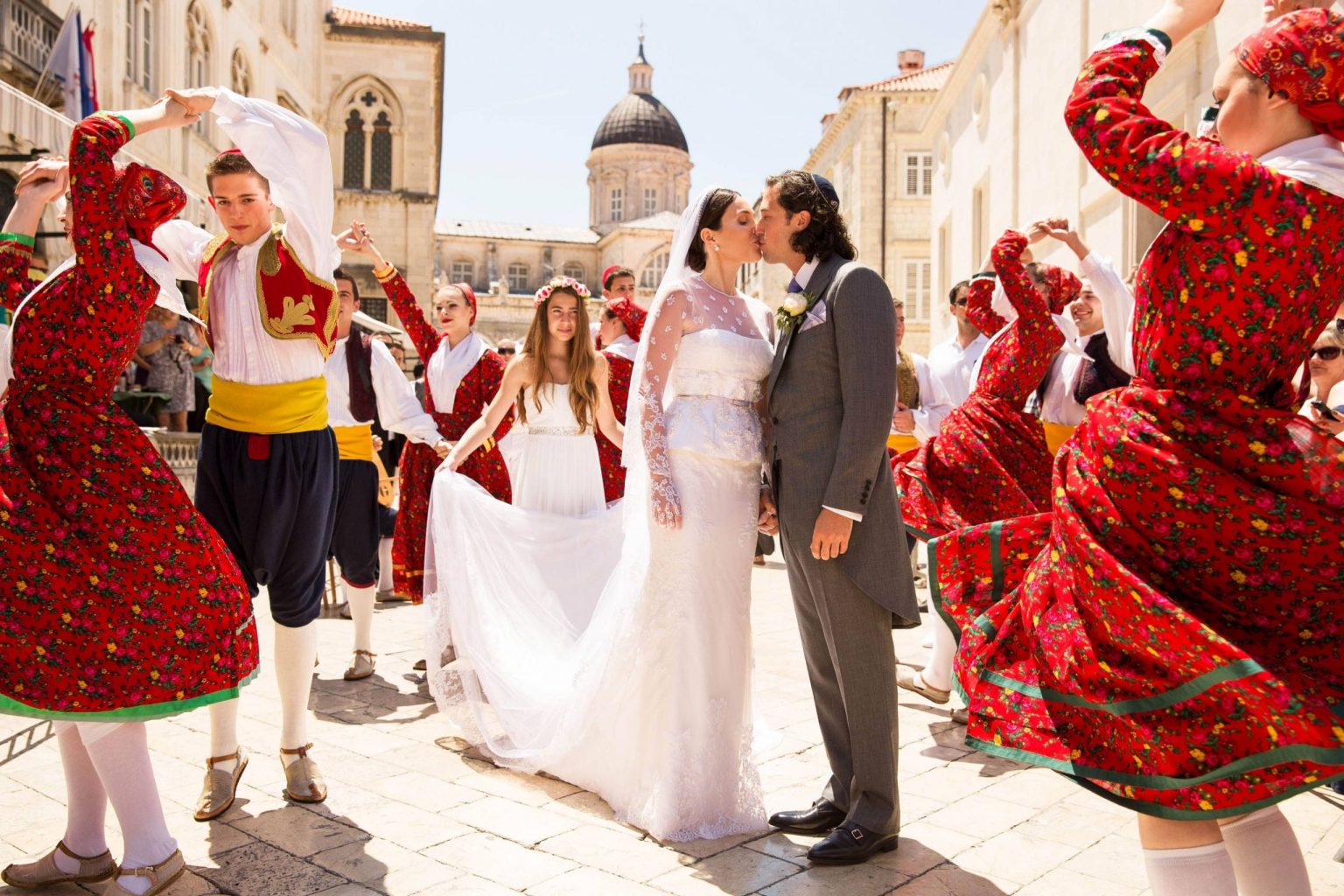
Croation wedding traditions
Croatian wedding traditions are deeply rooted in the country’s cultural heritage and often vary based on the region and local customs. Here are some common Croatian wedding traditions:
In Croatia, the equivalent of the maid of honor and best man are called “Kuma” and “Kumo.” They play an essential role in the wedding preparations and are responsible for various tasks to assist the bride and groom.
In a Croatian wedding, the “kumo” and “kuma” play important roles as the equivalent of the maid of honor and best man, respectively. Their roles are significant, as they are chosen by the bride and groom to assist and support them throughout the wedding preparations and ceremony. Here’s a breakdown of the roles of the kumo and kuma:
Kuma (Maid of Honor):
-
- Closest Female Friend or Family Member: The kuma is typically the bride’s closest female friend or a family member, such as a sister or cousin. She is chosen for her close relationship with the bride and her trustworthiness.
- Emotional Support: The kuma provides emotional support to the bride during the wedding planning process and on the wedding day. She is there to listen, offer advice, and be a calming presence.
- Wedding Planning Assistance: The kuma assists the bride in various wedding preparations, such as helping with the guest list, choosing the bridesmaid dresses, and organizing pre-wedding events like the bridal shower.
- Dressing the Bride: On the wedding day, the kuma helps the bride get dressed and ensures that everything is perfect with the bride’s attire and appearance.
- Witness during the Ceremony: During the wedding ceremony, the kuma stands beside the bride as a witness to the marriage vows and offers support and encouragement.
Kumo (Best Man)
-
-
- Closest Male Friend or Family Member: The kumo is usually the groom’s closest male friend or a family member, such as a brother or cousin. He is chosen for his strong bond with the groom and his reliability.
- Support and Organizing the Groom: The kumo is responsible for supporting the groom during the wedding preparations and on the wedding day. He helps the groom with various tasks and keeps him calm and relaxed.
- Handling Wedding Rings: The kumo is entrusted with the wedding rings and presents them to the couple during the wedding ceremony.
- Bachelor Party: The kumo is often in charge of organizing the groom’s bachelor party, a traditional pre-wedding celebration with close friends.
- Witness during the Ceremony: Similar to the kuma, the kumo stands beside the groom during the wedding ceremony as a witness to the marriage vows and offers support.
-
In Croatian weddings, the kumo and kuma are chosen with care, as their roles involve more than just fulfilling certain duties. They are meant to be loyal and supportive friends or family members who play a vital role in making the wedding day memorable and enjoyable for the couple. Their presence adds a sense of camaraderie and love to the celebration.
Purchasing the Bride:
The tradition of “purchasing the bride” in Croatian weddings is a lighthearted and symbolic custom that takes place before the wedding ceremony. It is not to be taken literally as buying the bride, but rather as a playful and fun tradition that adds to the joy and excitement of the wedding festivities. Here’s how the tradition typically unfolds:
- Arrival of the Groom and Groomsmen: On the wedding day, the groom, accompanied by his groomsmen, arrives at the bride’s family home or her place of getting ready.
- Meeting the Bride’s Family: The groom and his entourage are greeted by the bride’s family, who may playfully block the entrance to the house.
- Negotiating for the Bride: The groomsmen, acting on behalf of the groom, engage in playful negotiations with the bride’s family to “purchase” the bride. They may exchange humorous banter, jokes, and even haggle over the “price” of the bride.
- Gifts and Red Envelopes: As part of the tradition, the groom and his groomsmen present gifts and sometimes red envelopes with money to the bride’s family as a symbolic gesture of appreciation and respect. These gifts are a token of goodwill and are not intended as a payment for the bride.
- Bride’s Approval: Throughout the playful negotiation, the bride’s consent and approval are essential. The bride may come out to meet the groom and exchange some words or gestures before the “purchase” is completed.
- Entering the Bride’s House: After the playful negotiations, the groom and his entourage are usually allowed to enter the bride’s house, where they may share a toast or engage in further festivities.
- Continuation of the Celebration: The entire event is filled with joy, laughter, and celebration, setting a joyous tone for the rest of the wedding day.
It’s important to emphasize that this tradition is not meant to be taken literally, and there is no actual transaction involved. The idea behind “purchasing the bride” is to symbolize the groom’s love and commitment to the bride and to showcase the joy and camaraderie between the two families as they come together in celebration of the wedding. It is a cherished tradition that reflects the cultural values of Croatian weddings and highlights the joyous and communal spirit of the occasion.
A lighthearted tradition involves the groom and his groomsmen arriving at the bride’s house to “purchase” the bride. However, this is all in good spirits, and no actual money is exchanged.
The Wedding Procession:
The wedding procession is a lively event where the bride, groom, and their guests walk from the bride’s home to the church or wedding venue. It’s often accompanied by music, singing, and dancing.
he wedding procession in a Croatian wedding is a traditional and joyous event that involves the bride, groom, their families, and wedding guests walking from the bride’s home or a designated place to the church or wedding venue. It is a significant part of the wedding celebration and is accompanied by music, singing, and dancing. The wedding procession typically follows a specific order, and here’s how it usually unfolds:
- Groom and Groomsmen: The wedding procession begins with the groom and his groomsmen, who gather at the groom’s home or a nearby location. They are dressed in their best attire and may carry traditional accessories like decorative flags or scarves.
- Bride and Bridal Party: The bride and her bridal party, which may include bridesmaids and flower girls, gather at the bride’s home or another designated spot. The bride is usually adorned in her wedding gown, and the bridal party complements her attire with their dresses and flowers.
- Meeting Point: The groom’s and bride’s processions meet at a predetermined point, which is often in front of the bride’s home or at a town square. This meeting point symbolizes the joining of the two families.
- Musicians and Singers: Traditional musicians and singers often accompany the wedding procession, playing traditional Croatian music and singing wedding songs. Their music adds to the festive and celebratory atmosphere.
- Procession to the Church/Venue: Once the two processions have merged, the entire group proceeds together towards the church or wedding venue. The guests, along with the couple’s families, join in the procession.
- Dancing and Celebration: As the procession moves forward, guests may start dancing and singing along with the musicians. This joyful celebration continues throughout the journey.
- Reaching the Church/Venue: Upon reaching the church or wedding venue, the wedding procession enters in a festive manner. The couple is often greeted by the priest, and the ceremony commences.
- Church Ceremony: The wedding ceremony takes place, where the couple exchanges their vows and rings in the presence of their families and guests.
- Procession After the Ceremony: After the wedding ceremony is concluded, the couple exits the church or venue, and the wedding procession continues once again. Now, it leads the couple to their wedding reception venue.
- Reception and Celebrations: The wedding reception takes place at the chosen venue, where the couple and their guests enjoy a grand celebration with traditional Croatian food, drinks, music, and dancing.
The wedding procession in a Croatian wedding is a lively and cherished tradition that showcases the joy, unity, and cultural richness of the occasion. It allows the couple and their families to share their happiness with the community, and it is an integral part of the overall wedding festivities.
Ceremonial Bread:
In a Croatian wedding, the ceremonial bread is a significant element of the traditional wedding ceremony that takes place in the church. The bread used in the ceremony is called “česnica” or “kruh,” and it holds symbolic importance in the marriage ritual. Here’s a closer look at the ceremonial bread in a Croatian wedding:
- Symbolic Meaning: The ceremonial bread represents the unity and bond between the bride and groom, as well as the sharing of their lives together. It symbolizes their commitment to supporting and nourishing each other throughout their married life.
- Preparation and Design: The ceremonial bread is typically round in shape and intricately decorated with various patterns and motifs. It may have religious symbols or the initials of the bride and groom embedded on its surface.
- Blessing of the Bread: Before the wedding ceremony begins, the ceremonial bread is brought to the church and placed on the altar. During the wedding mass, the priest blesses the bread as part of the ceremony.
- Breaking of the Bread: At a specific point during the wedding ceremony, the bride and groom take the ceremonial bread and, together, break it into pieces. This act symbolizes the couple’s commitment to sharing their lives and supporting each other in all aspects of their marriage.
- Distribution to Guests: After the bread is broken by the couple, the pieces are often distributed to the congregation as a symbol of unity and goodwill. This act signifies that the couple’s love and commitment extend not only to each other but also to their family and community.
- Shared Meal: In some cases, after the wedding ceremony, the newlyweds and their guests may participate in a traditional “kolač” (cake) ritual. This involves the couple offering the ceremonial bread and a slice of wedding cake to guests as a gesture of hospitality and gratitude for their presence.
The ceremonial bread is a cherished part of Croatian wedding customs, representing the couple’s love and support for one another, as well as their connection to their community and shared cultural heritage. By incorporating this tradition into their wedding ceremony, Croatian couples honor their traditions and emphasize the importance of unity and mutual care in their marriage.
Traditional Costumes:
Traditional costumes are an essential and culturally significant aspect of a Croatian wedding, especially in rural areas and regions with a strong attachment to their cultural heritage. These costumes, known as “narodna nošnja” or “folk costumes,” vary based on the specific region and local customs. Here’s a glimpse into some of the traditional costumes you might encounter at a Croatian wedding:
Men’s Traditional Costume:
- Shirt: The traditional shirt, known as “košulja,” is usually white and intricately embroidered with patterns and designs on the sleeves and collar.
- Vest: The “prsluk” is a decorative vest, often made of vibrant and richly colored fabrics, worn over the shirt.
- Trousers: Traditional trousers called “gaće” are typically dark in color, such as black or brown.
- Sash: A colorful sash or “pojas” is wrapped around the waist, adding a touch of vibrancy to the ensemble.
- Footwear: Traditional footwear includes leather shoes or “opanci,” which are a type of traditional handmade sandals.
Women’s Traditional Costume:
- Blouse: The “bluza” is a white, long-sleeved blouse with delicate embroidery and lace details.
- Vest or Bodice: Women may wear a “prsluk” (vest) or “corap” (bodice) over their blouse, which is often adorned with elaborate floral patterns.
- Skirt: The “suknja” is a full, floor-length skirt, usually made from vibrant and colorful fabrics with floral motifs.
- Apron: A decorative apron or “kecelja” is worn over the skirt, adding another layer of intricately designed fabric.
- Headpiece: Women often wear a headpiece or “kapica,” which can vary based on the region. It may be a small cap, a scarf, or a decorative wreath of flowers.
- Jewelry: Traditional Croatian jewelry, such as gold necklaces, earrings, and brooches, is also commonly worn as part of the ensemble.
It’s important to note that traditional costumes can differ significantly depending on the specific region in Croatia. Each area has its unique designs, colors, and accessories, reflecting the cultural diversity and distinct heritage of the country. When a couple chooses to incorporate traditional costumes into their wedding, it not only highlights their pride in their cultural identity but also adds a touch of authenticity and historical significance to the celebration.
Wedding Flags:
Wedding flags, also known as “zastava” or “barjak,” are a traditional and decorative element commonly seen at Croatian weddings. These flags hold cultural significance and are used to symbolize the joyous occasion and unity of the couple. Here’s more about the role and significance of wedding flags at Croatian weddings:
- Symbol of Celebration: Wedding flags are vibrant and colorful, often featuring traditional patterns and motifs. They are raised at the homes of both the bride and groom on the day of the wedding to signal the festive occasion to the community.
- Indication of a Wedding: The sight of wedding flags raised outside the homes of the couple is a clear indication to neighbors and passersby that a wedding is taking place. It invites well-wishers and guests to join in the celebration.
- Community Involvement: Raising wedding flags is not solely the responsibility of the couple or their families. It often involves the participation of friends and neighbors who come together to decorate and hoist the flags as a communal gesture of support and goodwill.
- Traditional Designs: The design of the wedding flags is inspired by traditional Croatian patterns and motifs. These designs can vary depending on the specific region, reflecting the diverse cultural heritage of Croatia.
- Color Symbolism: The colors used in the wedding flags carry symbolic meanings. Red, for example, symbolizes love, joy, and happiness, while white represents purity and new beginnings. Other colors may also hold regional or cultural significance.
- Festive Procession: On the wedding day, the couple, along with their families and guests, often partake in a festive procession from the bride’s home to the church or wedding venue. Wedding flags may be carried or waved during this procession, adding to the joyful atmosphere.
- Display at the Reception: Wedding flags may also be displayed at the wedding reception venue, contributing to the overall ambiance of the celebration.
- Souvenirs and Keepsakes: After the wedding, some of the wedding flags may be taken down and given to the couple as keepsakes or souvenirs to remember their special day.
Incorporating wedding flags into Croatian weddings is a cherished tradition that reflects the cultural pride, sense of community, and joyous spirit of the occasion. It showcases the couple’s connection to their heritage and serves as a beautiful symbol of love and unity during their wedding celebrations.
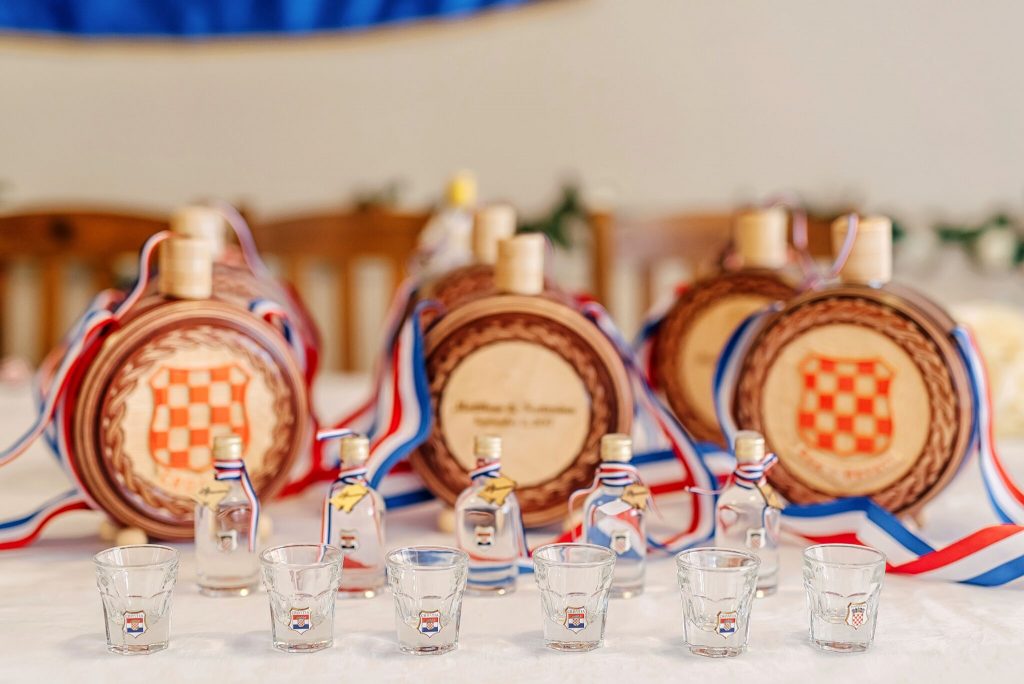
Wedding Feast:
A Croatian wedding feast is a grand and lavish affair, characterized by a rich variety of delicious dishes, local specialties, and an abundance of food and drinks. It is an integral part of the wedding celebration and serves as a time for family and friends to come together, enjoy good food, and celebrate the joyous occasion. Here’s what a Croatian wedding feast typically looks like:
1. Appetizers and Welcome Drinks: The feast often begins with a selection of appetizers, including cured meats (such as prosciutto and kulen), cheeses, olives, pickles, and various spreads. Welcome drinks, such as traditional Croatian liqueurs or aperitifs, are also served to guests as they arrive.
2. Traditional Croatian Dishes: The main course of the feast consists of a variety of traditional Croatian dishes, which can vary based on the region and local customs. Some popular dishes include:
- Peka: A delicious dish prepared by cooking meat (usually lamb, veal, or chicken) with potatoes and vegetables under a bell-shaped lid over an open fire.
- Čevapi: Grilled minced meat sausages, often served with flatbread (lepinja) and onions.
- Sarma: Cabbage rolls stuffed with a mixture of minced meat and rice, cooked in a tomato-based sauce.
- Brudet: A fish stew made with various types of fish, tomatoes, onions, and spices.
- Pašticada: A slow-cooked beef stew with red wine and prunes, often served with gnocchi or homemade pasta.
3. Seafood Delicacies: If the wedding is held in a coastal region, seafood plays a prominent role in the feast. Fresh fish, grilled seafood, and dishes like black risotto (made with cuttlefish ink) may be included.
4. Side Dishes and Salads: Side dishes often accompany the main course and may include roasted or boiled potatoes, seasonal vegetables, and various salads made with fresh ingredients.
5. Desserts: Croatian desserts are delightful, with an array of options to satisfy guests’ sweet cravings. Traditional desserts like “krafne” (doughnuts), “kroštule” (fried pastries), and “fritule” (small doughnuts with raisins) are commonly served. A wedding cake is also a highlight of the dessert selection.
6. Wines and Beverages: Croatia is known for its excellent wines, and the wedding feast features a selection of local wines to complement the meal. Additionally, guests can enjoy various non-alcoholic beverages, fruit juices, and mineral water.
7. Toasts and Celebrations: Throughout the feast, there are many toasts and expressions of good wishes for the couple’s future. Guests raise their glasses, clink them together, and offer heartfelt congratulations.
8. Dancing and Music: After the feast, the celebration continues with music, singing, and dancing, as guests enjoy the festive atmosphere and join the newlyweds on the dance floor.
A Croatian wedding feast is a delightful experience that showcases the country’s culinary richness and hospitality. It brings together family, friends, and guests to share in the couple’s happiness and create lasting memories of the joyous occasion.
Money Dance (Baliranje):
At a Croatian wedding, the Money Dance, known as “Baliranje,” is a fun and interactive tradition that involves guests pinning money onto the clothing of the bride and groom as a way to give them monetary gifts. It is a lighthearted and joyous activity that adds excitement and celebration to the wedding reception. Here’s how the Money Dance typically works at a Croatian wedding:
- Announcement and Invitation: The Money Dance is usually announced by the Master of Ceremonies (MC) or a member of the wedding party. They invite guests to participate in the tradition and explain how it works.
- Dance with the Couple: During the Money Dance, guests take turns dancing with the bride and groom. The couple dances together in the center of the dance floor, and one guest at a time joins them for a short dance.
- Pinning the Money: While dancing with the bride or groom, guests discreetly pin money onto their clothing. The money can be in the form of banknotes or coins. The amount of money given varies from guest to guest, and there is no set rule for how much to give.
- Well Wishes: As guests pin the money, they may also offer well wishes, blessings, or words of encouragement to the couple.
- Symbolism and Good Luck: The Money Dance is seen as a symbol of good luck and prosperity for the newlyweds. By pinning money onto the couple’s clothing, guests are expressing their support and best wishes for the couple’s future together.
- Entertainment and Celebration: The Money Dance is not just a gift-giving tradition; it’s also an entertaining and festive activity. The dance floor becomes lively and spirited as guests participate and celebrate with the couple.
- Collection: Typically, there is a designated person, often a member of the wedding party or a close friend, who collects the pinned money from the couple’s clothing and keeps it safe during the event.
- Use of the Money: The money collected during the Money Dance is intended as a gift for the couple to help them start their married life or to contribute to their future plans.
The Money Dance at a Croatian wedding is a cherished tradition that brings a sense of community and togetherness to the celebration. It allows guests to actively participate in the couple’s happiness and show their love and support through the symbolic act of pinning money onto the bride and groom’s attire.
Tying the Knot:
Tying the knot at a Croatian wedding is a beautiful and symbolic tradition that represents the couple’s unity and commitment to each other. It is a special moment during the wedding ceremony that holds cultural significance and reflects the couple’s intention to be bound together in marriage. Here’s how “tying the knot” is typically carried out at a Croatian wedding:
- Ceremony Setting: Tying the knot usually takes place as part of the wedding ceremony, often during the exchange of vows or after the couple has been pronounced husband and wife by the officiant.
- Braided or Decorative Ribbon: For this ritual, a braided or decorative ribbon is used, often in colors that hold symbolic meaning. The ribbon may be in the traditional Croatian colors of red and white, or it could be personalized to match the couple’s wedding theme.
- Hands Joined Together: During the ceremony, the bride and groom extend their hands, palms facing each other, while holding the ribbon between them. Their hands are gently held by the officiant, a family member, or a designated person, signifying the support and blessing of the community and loved ones.
- Symbolic Gesture: Tying the knot is a symbolic gesture that signifies the couple’s intention to be bound together in marriage. It represents the joining of their lives, hearts, and souls as they embark on their journey together as husband and wife.
- Exchange of Vows or Blessings: While the ribbon is held between the couple’s hands, they may choose to exchange personalized vows or receive blessings from the officiant or other family members. This adds a personal touch to the ritual and deepens the significance of the moment.
- Permanent Keepsake: After the ceremony, the braided ribbon becomes a cherished keepsake for the couple, symbolizing their bond and the vows they have made to each other.
Tying the knot is a beautiful and poignant moment during a Croatian wedding, symbolizing the couple’s commitment to each other and their readiness to face the journey of marriage together. It’s a touching representation of the love and unity shared between the bride and groom and a reflection of the cultural heritage and traditions of Croatia.
Bonfire Dance (Kolo):
The Bonfire Dance, known as “Kolo” in a Croatian wedding, is a traditional and joyful folk dance performed around a bonfire. It is a lively and spirited celebration that brings together the wedding guests to dance and sing in a circle, fostering a sense of community and unity. The Bonfire Dance holds cultural significance and is a cherished tradition in Croatian weddings. Here’s how the Bonfire Dance (Kolo) is typically carried out:
- Bonfire Setting: The Bonfire Dance usually takes place in the evening, after the wedding ceremony and dinner. A bonfire is lit at a designated area, often outdoors, where guests can gather around.
- Formation of the Circle: Guests join hands and form a circle around the bonfire. The circle can be as small as a few people or large enough to include all the wedding guests.
- Traditional Music and Singing: Musicians play traditional Croatian music, and singers may lead the guests in singing traditional wedding songs. The music is lively and upbeat, encouraging everyone to participate.
- Dancing Steps: The dance steps in Kolo are typically simple, making it easy for everyone to join in the dance, regardless of age or experience. Participants move in a circular pattern, stepping to the beat of the music.
- Inclusion and Fun: The Bonfire Dance is an inclusive and joyous activity, where everyone can take part and enjoy the celebration. It’s a time for laughter, camaraderie, and creating memorable moments.
- Symbolism of the Circle: The circular formation of the dance symbolizes unity, continuity, and the cyclical nature of life. It reflects the communal bond shared among the wedding guests and the couple.
- Energy and Spirit: The dance continues for as long as the guests wish to participate, with the energy and spirit building as the night goes on.
- Emphasis on Tradition: The Bonfire Dance is a celebration of Croatian culture and traditions. By incorporating this dance into the wedding festivities, the couple honors their cultural heritage and shares it with their family and friends.
The Bonfire Dance (Kolo) is a cherished tradition at Croatian weddings, representing the country’s rich cultural heritage and emphasizing the sense of community and togetherness during the celebration. It adds a vibrant and festive atmosphere to the wedding, creating lasting memories of love and joy shared among the couple, their loved ones, and their community.
In certain regions, a bonfire dance called “kolo” is performed during the wedding reception. Guests join hands and dance around the bonfire in a circle, fostering a sense of community and unity.
In Summary
A traditional Croatian wedding is a vibrant and joyous celebration deeply rooted in the country’s cultural heritage. It offers a unique and rich experience that showcases the love, unity, and values of the couple and their community

